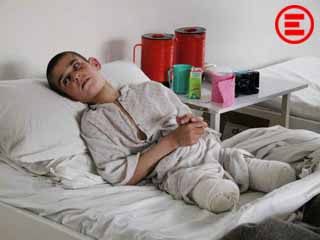Targeting Civilians: Anti-Personnel Landmines
Maria | 20.04.2004 23:00 | Anti-militarism | Cambridge

Afghanistan Landmine Victim
The Valmara 69 is a "fragmentation" mine: when it is primed by the tension of a metallic thread connected to one of its spikes it "jumps" to 80 cm height from the ground and subsequently explodes shooting about 2,000 metallic fragments in every direction. It can kill and wound at distances of up to 27 and 200 metres respectively. Many other APLs are of the "explosion" type, such as the M-14 made in the USA, the PMN made in Russia, and Type 72 made in China. This type of mine are activated by pressure and produce a traumatic amputation of the foot or of the leg. In some cases both feet or legs are amputated. An infamous type of mine that Soviet forces spread by the millions in Afghanistan is known as the "butterfly mine" or the "toy mine". They look like toys. No soldiers, no adults would ever pick them up. They target children: tens of thousands of Afghan children have been mutilated by these mines. The technology of barbarity has "perfected" these loathsome devices: they do not explode immediately, several applications of pressure are necessary on their "wings" such as those produced when they are held in a hand. So the child can take it home, maybe even play a bit with it. Then the explosion comes, maybe more than one child will be hit [2]. Arm dealers call it "top performance".
People cry for the dead but it does not cost, while an invalid child will be in need of care for the rest of his life. Of the victims of APLs two out of three patients remain mutilated. It is the terrible logic of these inhuman weapons: mutilate rather than kill, to inflict prolonged suffering and create enormous difficulties not only to the victims but also to their families and society.
It is estimated that there are more than 100 millions mines on the ground of 67 countries, and at least 25,000 victims per year. Dropped by helicopters, thrown by motor vehicles or positioned by hand, APLs, once on the ground, become invisible and patient snipers, waiting years for the step of the one who will prime them. In a short time dried leaves and branches hide them; floods or the melting of glaciers move them. Meanwhile the mines wait, resistant to water, cold, and heat, insensitive to peace treaties, indifferent to laws.
Antiman mines do not only act when they wound, kill and mutilate. Their laying on the ground is terror, threat, prohibition. The signs that warn of the danger are also a prohibition: to move, to cultivate, to graze, to play, to collect wood. Those signs mean: here life is prohibited. Antiman mines render entire regions uninhabitable.
The Ottawa Convention, also referred to as the "Mine Ban Treaty", prohibits the use, stockpiling and production of APLs. The convention entered into force on March 1st, 1999 and by October 1st, 2003 139 countries had ratified the treaty. States overwhelmingly come from Europe, Africa, Latin America and the Carribean. Almost no countries in the Near East and only about half of the countries in the Asia-Pacific region have signed the treaty. Some key current and past producers of landmines, including the USA, China, Russia, India and Pakistan have not signed the treaty. While in office President Clinton pledged the USA would sign the treaty by 2006 if they succeeded in "identifying and fielding suitable alternatives". Yet cluster bombs - defacto landmines - have been serving a similar purpose for many years now. The other purported reason for the US not signing has been their "importance" in the Korean peninsula, a thoroughly discredited arguement. In any case, the Bush administration appears to be backing away from the Clinton pledge [3]. The International Campaign to Ban Landmines, a coalition of more than 1,400 NGOs working on landmine issues recently estimated that about 80 countries may be stockpiling as many as 215 million APLs, of which about 10 million are stockpiled by Ottawa convention signatories.
Ashad, a Kurdish twelve-year-old, has already spent a fourth of his life walking with only one foot. He was nine years old when a landmine mutilated him. While hobbling on crutches Ashad is in charge of accompanying his father who also, years before, had encountered a mine, which blinded him. Neither of them has ever been a combatant, neither of them has ever been wounded fighting. They are civilian victims of war, they have been hit in a time of peace. The sufferings of a father and a son exhibit the nature of modern war: no more a clash of armies, but "technologically advanced" violence against defenceless populations.
Notes:
- [1] Italian NGO whose aim is to provide support for civilian victims of war (http://www.emergency.it, English version available). Much of this article has been extracted from a brochure produced by Emergency.
- [2] More information on the effects of landmines in particular on children can be found, among many other sites, at: http://www.unicef.org, http://www.warchild.ca and http://www.mines.gc.ca.
- [3] For more information check http://www.armscontrol.org.
Maria